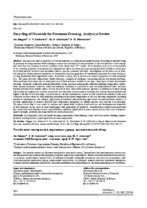| dc.description.abstract | The paper presents an analytical review of materials recycling for pavement dressing. Recycling or repeated usage of pavement dressing materials while making reconstruction and repair of road pavements is not considered as a new conception and it has been realized in various countries of the world since 20th century. Recycling (hot, cold) is based on methods of its execution, properties of pavement dressing materials which are subjected to processing and which influence on the quality of final material, technical and operational indices, specific economic efficiency. Investigations on the processes of structure formation, thermo-physical properties in components based on granulates of transformed pavement dressings during recycling demonstrate that regeneration makes it possible to attain 100 % recovery of material properties for road pavement base. The paper describes other factors which represent a complex of challenges concerning exterior and internal problems. These problems have arisen due to actual processes of heat and mass transfer in one layer, multilayer systems of pavement dressings. At known coefficients of heat conductivity, steam- and mass permeability, diffusion, filtration, temperature conductivity, density of material layers etc. initial and boundary conditions it is possible to carry out optimization of heat- and mass transfer problems from bottom surface of road layer to its base (sand, bulk materials, ground). In addition to it, while taking into account development of scientific prospective direction that concerns nanotechnology and creation of nanomaterials for higher reliability of road dressings it is necessary to consider nanomaterial science in road-construction industry as the most actual one because when we study problems pertaining to fractional composition of all road dressing components including transfer to nanomaterials, for example, application of modified water-reducing agent based on nanostructured carbon it is possible significantly to increase physical and technological properties of asphalt concrete and concrete road dressings. The paper reveals that it is necessary to continue and expand study of physical and technical and thermophysical properties of new materials on the basis of nanotechnologies with application of modified, nanostructured carbon-based plasticizer for construction-road industry because especially these additives significantly increase cement activity that leads to improvement of strength, reliability and longevity for the obtained materials. | ru |
| local.description.annotation | Рассмотрен анализ ресайклинга материалов дорожных одежд. Переработка или многократное использование материалов одежд при реконструкции и ремонте дорожных покрытий не является новой концепцией и реализуется в разных странах мира с начала ХХ в. Ресайклинг (горячий, холодный) основан на способах его реализации, свойствах материалов дорожных одежд, подлежащих переработке, от которых зависят качество конечного материала, технико-эксплуатационные показатели, удельная экономическая эффективность. Исследования процессов структурообразования, теплофизических свойств компонентов на основе гранулятов трансформируемых дорожных покрытий в процессе ресайклинга показывают, что при регенерации добиваются полного восстановления свойств материалов для устройства оснований дорожных покрытий. В статье описываются другие факторы, которые представляют комплексы вопросов, относящиеся к «внешней» и «внутренней» задачам. Эти задачи обусловлены реальными процессами тепло- и массопереноса в одно- и многослойных системах дорожных одеждах. При известных коэффициентах теплопроводности, паро- и массопроницаемости, диффузии, фильтрации, температуропроводности, плотности материалов слоев и т.д., начальных и граничных условиях возможна оптимизация проблем тепло- и массопереноса от «нижней» поверхности слоя дороги к ее основанию (песок, сыпучие материалы, грунты). Кроме того, с учетом развития научно-перспективного направления, связанного с разработкой нанотехнологий и созданием наноматериалов для повышения надежности дорожных одежд, необходимо рассматривать наноматериаловедение в строительно-дорожной отрасли как наиболее актуальное, так как, изучая вопросы фракционного состава всех компонентов, составляющих дорожную одежду, включая переход к наноматериалам, например применение модифицированной пластифицирующей добавки на основе наноструктурированного углерода, можно значительно повысить физико-технологические и теплофизические свойства асфальтобетонных и бетонных цементных дорожных одежд. В статье показано, что необходимо продолжить и расширить изучение физико-технических и теплофизических свойств новых материалов на основе нанотехнологий с применением модифицируемой, пластифицирующей добавки на основе наноструктурированного углерода для строительно-дорожной отрасли, так как именно эти добавки значительно увеличивают активность цемента, что приводит к повышению прочности, надежности и долговечности полученных материалов. | ru |

